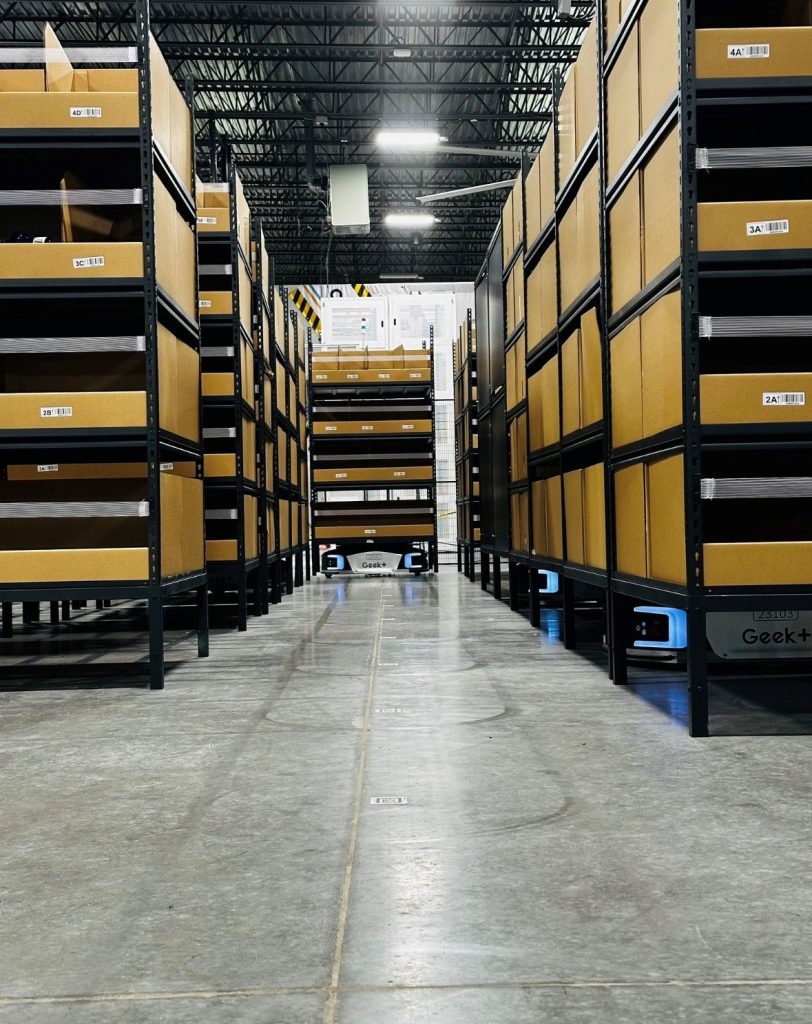Insights from John Padgett, Systems Development Lead
Adopting Goods-to-Person (G2P or GTP) robotics is a bold step toward optimizing your warehouse or distribution center. These systems can drastically reduce picking times, improve order accuracy, and mitigate labor challenges—but they’re far from an off-the-shelf solution.
The automation market is rapidly growing, with an expected 50 percent increase in robotic shipments every year through 2030, according to McKinsey & Company, underscoring the urgency for businesses to strategically plan their adoption. Implementing GTP robotics requires careful planning to ensure they align with your specific operational needs and goals.
Before implementing goods-to-person robotics, take time to evaluate your readiness. Asking the right questions early on can prevent costly missteps and help you unlock the full potential of these advanced systems.
What Are Goods-to-Person Robotics?

Goods-to-person robotics revolutionize traditional picking processes by bringing inventory directly to warehouse operators. Unlike conventional systems, where workers travel to shelves to retrieve items, G2P systems rely on robotic units to transport storage bins, totes, or trays to stationary workstations.
Here’s how they work:
- Storage and Retrieval: Items are stored in plastic bins, in racking, or stacked on the floor, often optimized for space efficiency. Robots manage all the movements of bins inside the system.
- Robot Movement: When an order is received, robots locate the necessary bin and transport it to a picking station.
- Operator Picking: Operators pick the items needed for the order and robots send the bin back into the system.
GTP systems improve picking speed, reduce physical strain on workers, and increase accuracy by minimizing human error. They’re particularly well-suited for high-volume, high-SKU environments, such as e-commerce fulfillment centers or industries like retail and omnichannel.
Ready to Start Implementing Goods-to-Person Robotics? Start by Asking the Right Questions
Implementing Goods-to-Person robotics isn’t just about upgrading your warehouse; it’s about making strategic decisions that align with your specific needs and goals. To set yourself up for success, it’s crucial to evaluate your readiness from multiple angles.
The following five questions are designed to help you assess your operations, infrastructure, and workforce, ensuring you’re prepared to unlock the full potential of GTP robotics. Let’s dive in.
1. What Are My Current Operational Pain Points?
The first step toward a successful GTP robotics implementation is to understand the specific challenges you are trying to solve. Every warehouse has pain points, but not all are best addressed with automation.
Ask yourself:
- Are picking errors affecting customer satisfaction?
- Is your staff spending too much time walking between aisles?
- Are labor shortages making it difficult to meet demand?
For instance, G2P systems can be transformative if your bottlenecks are related to slow picking speeds or inefficient use of space. However, if your challenges stem from upstream processes like inbound logistics or inventory inaccuracies, addressing those areas first might yield better results.
Automation Insider Tip: Conduct a thorough operational audit to identify inefficiencies. Partnering with experts, such as our consulting team at Hy-Tek, who can analyze your workflows and suggest tailored solutions is invaluable.
2. Is My Warehouse Ready to Start Implementing Goods-to-Person Robotics?
GTP robotics are advanced systems that require specific infrastructure to function effectively. It’s not just about floor space; it’s about having the right technology backbone to support automation.
Here’s what to evaluate:
- Physical Space: Do you have enough room to accommodate robotic systems, workstations, and optimized storage layouts? Is your facility level, with smooth and even flooring that ensures safe and efficient movement for robots? Does your facility have adequate fire protection to support dense storage?
- Technology Compatibility: Does your existing warehouse management system (WMS) integrate with GTP systems, or will it require upgrades?
- Power and Connectivity: Advanced robotics depend on reliable power sources and robust wireless networks to operate without interruptions.
- Accurate Data: Do you have accurate order data and an up-to-date item reference list of all your inventory? Sizing GTP systems relies on accurate information to determine storage location sizes and requires throughput targets to meet your business objectives.
Automation Insider Tip: Many businesses underestimate the need for seamless WMS integration. If your WMS doesn’t effectively communicate with G2P robotics, it could lead to delays, inefficiencies, or even critical system failures.
3. What’s My ROI Timeline?
Implementing Goods-to-Person Robotics is a significant financial commitment. Understanding your return on investment (ROI) timeline is essential for making an informed decision.
Consider the following factors:
- Initial Costs: Account for hardware, software, installation, and any infrastructure upgrades required.
- Operational Savings: Factor in reduced labor costs, increased throughput, and improved accuracy.
- Space Savings: Often, implementing a GTP system will result in space savings that can either be repurposed for other uses or deferred entirely in greenfield applications.
- Transportation Savings: GTP systems allow for all items to be picked at one location, which means that consolidation of multi-line orders is automatic and in general reduces the number of shipping containers leaving the building as compared to manual systems that might have multiple picking zones and split shipments.
- Payback Period: On average, companies see ROI within 2–4 years, but this varies based on industry, volume, and existing inefficiencies.
Automation Insider Tip: Develop a detailed ROI model that aligns with your business goals. Look beyond financial returns and consider operational benefits, such as increased capacity, reduced manual labor dependency, or the ability to scale during peak seasons.
4. How Will This Impact My Workforce?
Automation doesn’t mean replacing people, it means redefining their roles. Implementing Goods-to-Person Robotics will shift how your team operates, and planning for that transition is critical.
Ask yourself:
- What tasks will my team no longer need to perform?
- Will employees require training to operate and maintain the new system?
- How can I engage my workforce and address concerns about automation?
Successful implementations blend human expertise with robotic efficiency. For example, while robots handle repetitive tasks like transporting bins, employees can focus on quality control, exception handling, or higher-level operational decisions.
Automation Insider Tip: Communicate openly with your team about the benefits of automation. Involving employees early can reduce resistance and foster a sense of collaboration. For more on how automation can coexist with employee retention strategies, check out this Forbes article exploring the relationship between warehouse automation and workforce engagement.
5. Am I Choosing the Right Partner for Implementation?
Your choice of partner can make or break the success of implementing the Goods-to-Person Robotics system project. The right provider will guide you through every phase—from design to deployment to ongoing optimization.
When evaluating potential vendors, ask these questions:
- Experience: Do they have a proven history of implementing GTP systems in facilities like mine?
- Client Sites: Can they take you to a client site so you can see the automation for yourself and meet with people who were in your shoes at the start of their automation journey?
- Support: What level of customer service and maintenance do they provide for post-implementation?
- Scalability: Can the system grow with my business as my needs evolve?
Automation Insider Tip: Partnering with an experienced integrator is key to successful implementation. Look for a team that takes the time to understand your unique needs, provides expert guidance throughout the process, and offers ongoing support to ensure your system continues to deliver value as your business evolves.
Final Thoughts
Goods-to-person robotics represent a transformative leap for warehouse operations, offering significant advantages in speed, accuracy, and labor efficiency. However, achieving these benefits requires more than just purchasing the right equipment—it demands strategic planning, infrastructure readiness, and a commitment to integrating technology with human expertise.
By asking the right questions early—about your operational pain points, infrastructure, ROI, workforce impacts, and implementation partners, you set the stage for success. Thoughtful preparation minimizes risks, maximizes your investment, and ensures that the system you choose delivers long-term value.
At Hy-Tek Intralogistics, we understand that no two operations are the same. That’s why we take a tailored approach, leveraging our expertise and solutions like IntraOne to create seamless integrations that align with your unique needs. Whether you’re tackling labor shortages, increasing throughput, or preparing for future growth, our team is here to help you unlock the full potential of automation.
IntraOne is designed to function as the central hub, connecting your WMS to advanced automation systems like GTP robotics. Its robust integration capabilities ensure that data flows seamlessly, enabling real-time decision-making, precise inventory management, and efficient robotic operations.
By implementing IntraOne, you can eliminate the risks associated with disconnected systems and optimize your automation performance. Whether it’s adapting to high order volumes or ensuring scalability for future growth, IntraOne provides the technological foundation your warehouse needs to thrive.
Ready to transform your operations? Contact Hy-Tek today to start building a solution that drives efficiency, scalability, and success for years to come.





